VIA PT880 PRO: Biostar’s Deluxe Dual Combo
by Gary Key on March 20, 2006 12:05 AM EST- Posted in
- Motherboards
Gaming Performance
Again, we have listed performance scores with the various RAM types. We could not get DDR memory to run at better timings. However, our gaming benchmarks show a different pattern from the synthetic test results with our DDR scores equaling or exceeding DDR2 in most results.
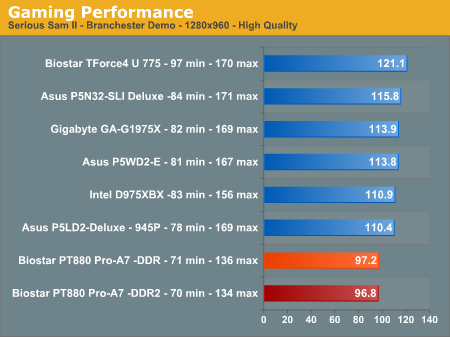
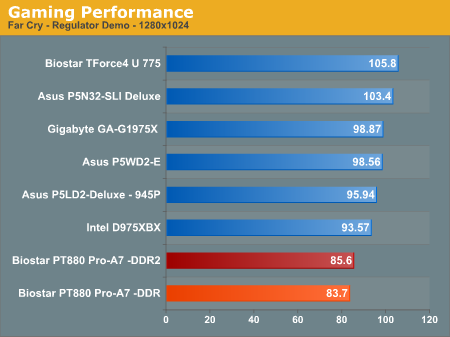
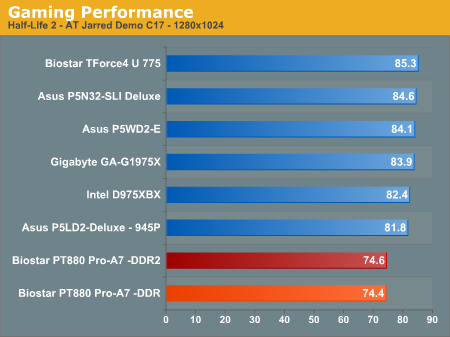
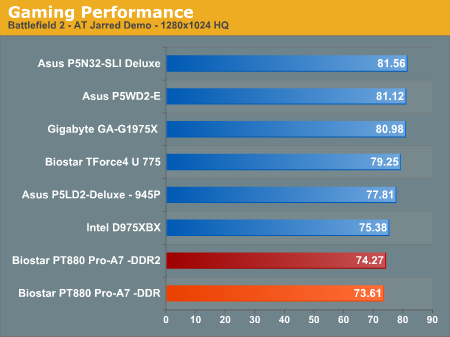
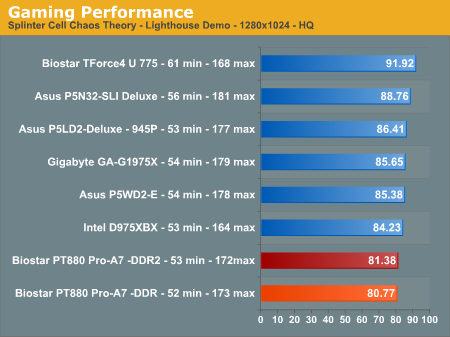
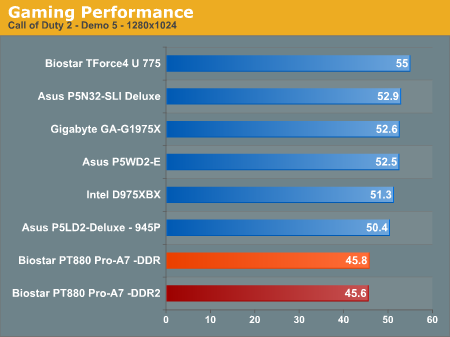
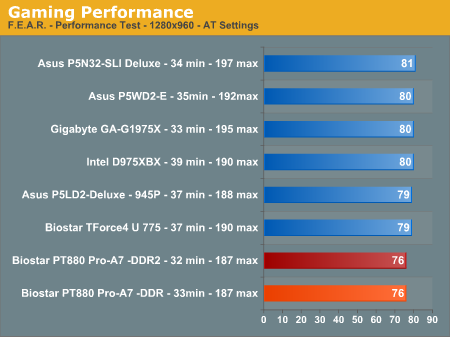
Again, we have listed performance scores with the various RAM types. We could not get DDR memory to run at better timings. However, our gaming benchmarks show a different pattern from the synthetic test results with our DDR scores equaling or exceeding DDR2 in most results.










17 Comments
View All Comments
Rza79 - Wednesday, March 22, 2006 - link
I would say the Asus P5VD1-X is a 10x better option than this board.- PT880Ultra instead of PT880Pro
- Asus doesn't use OST caps
- gigabit lan controller
- space in between the AGP and PCI-E slot so you can actually put two cards
- can be found as low as 50 euro
It would be nice if you reviewed this board too. I used it and it really did good.
Marlin1975 - Wednesday, March 22, 2006 - link
Thats the PT880 board I am running now. It does not have voltage mods for the CPU but I was told the next Bios update will fix that. :)Per Hansson - Tuesday, March 21, 2006 - link
Gary, sigh, I whined about this in your Epox review and I'll do it in this one tooThe Caps used on the board for the VRM section are excellent brand by United Chemi-Con, for the smaller caps they used the crap-brand OST that will prolly fail within the boards useful life if they are installed in any high ripple areas, which they seem to be (chipset, memory and expansionslots....) Please atleast provide pictures where you can read the make and model of the caps
Next; PCI-E 4x has low bandwidth; well, compared to AGP 3.0 it is 2.0GB/s, and guess what, AGP 3.0 has 2 GB/s too... So the issue is not with too little bandwidth but something in the implementation...
Most serious is the fact that there is no mention about the fact that the VT8237R does not support SATA2 harddrives, i.e. they do not work at all with it! Only the VT8237R+ support SATA2 properly, this is a design issue in the following chipsets: VT8237, VT8237R, VT6420 and VT6421L
http://www.theinquirer.net/?article=24910">http://www.theinquirer.net/?article=24910
Rza79 - Wednesday, March 22, 2006 - link
While i know OST caps are cheap and come from Taiwan, still i have to see a blown up one. Asrock is using them from the start and those first boards are still working good for me. Still, better ones are good but OST isn't crap but just worse. Big difference.PCI-E 4x has 2GB/s bandwidth in total, what means 1GB/s per direction. So it can read 1GB/s and write at 1GB/s. Since these stuff are reading most of the time ...
AGP can use it bandwidth in both directions meaning it can read at 2GB/s or write at 2GB/s. But the benchmarks do show that 1GB/s for reading is just not enough for these highend cards.
About the Sata2 incompability. The southbridges you mention do have a detection issue. But any Sata2 hdd can be to Sata1 by jumper. When you do that, they will just work. Actually hdd's from Samsung, ... are set to Sata1 by default and have to be set manually to Sata2 by jumper.
All the lastest Via boards i got from Asus (last month) had the Plus version of the southbridge, so you don't need to bother any longer about it either.
Gary Key - Friday, March 24, 2006 - link
"Next; PCI-E 4x has low bandwidth; well, compared to AGP 3.0 it is 2.0GB/s, and guess what, AGP 3.0 has 2 GB/s too... So the issue is not with too little bandwidth but something in the implementation...Most serious is the fact that there is no mention about the fact that the VT8237R does not support SATA2 harddrives, i.e. they do not work at all with it! Only the VT8237R+ support SATA2 properly, this is a design issue in the following chipsets: VT8237, VT8237R, VT6420 and VT6421L "
The PCI-E 4x comments have been clarified by RZA79 already. Our features chart and text clearly indicated the VIA VT8237R was a SATA 1.5Gb/s controller. However, I obviously did not clearly state this in the article. :) I updated the Final Words section based upon your comments. In our testing with this controller, our Maxtor, WD, Seagate, and Samsung 3Gb/s drives all worked fine with the jumpers set to 1.5Gb/s. Thanks!!!
Per Hansson - Wednesday, March 22, 2006 - link
Yea right, OST is great...ASUS P5GDC-V DELUXE LGA775
http://www.badcaps.net/forum/showth...ghlight=p5gd...">http://www.badcaps.net/forum/showth...ghlight=p5gd...
Shuttle MS50N s478
http://www.badcaps.net/forum/showth...highlight=ms...">http://www.badcaps.net/forum/showth...highlight=ms...
MSI MS-6741 s754
http://www.badcaps.net/forum/showth...7&highli...">http://www.badcaps.net/forum/showth...7&highli...
Matsonic MS8318E s462
http://www.badcaps.net/forum/showth...1&highli...">http://www.badcaps.net/forum/showth...1&highli...
I had no idea about the PCIe bandwidth info... Interesting to say the least
And last, I bought a friend a 500GB Seagate Barracuda, it did not get recognized by his mobo (8237 southbridge) I contacted Seagate by phone, the tech said I was supposed to put a jumper between two of the pins, it did not help, so I had to buy him an external controller
Per Hansson - Wednesday, March 22, 2006 - link
Sorry, links trancuated...ASUS P5GDC-V DELUXE LGA775
http://www.badcaps.net/forum/showthread.php?t=843">http://www.badcaps.net/forum/showthread.php?t=843
Shuttle MS50N s478
http://www.badcaps.net/forum/showthread.php?t=481">http://www.badcaps.net/forum/showthread.php?t=481
MSI MS-6741 s754
http://www.badcaps.net/forum/showthread.php?t=1127">http://www.badcaps.net/forum/showthread.php?t=1127
Matsonic MS8318E s462
http://www.badcaps.net/forum/showthread.php?t=251">http://www.badcaps.net/forum/showthread.php?t=251
Wonga - Monday, March 20, 2006 - link
From this review, you can certainly see that AMD made a good choice going for an IMC - relying on VIA, they'd always be in second place.Not that VIA chipsets are bad to use, but they certainly aren't the quickest...
lemonadesoda - Monday, March 20, 2006 - link
Something isn't quite right here. If you want to provide an upgrade path for basic users, start with what they have already:1./ CPU - 478 (this is an intel example)
2./ GPU - AGP
3./ Memory - DDR
And cost/price of the original components (and their new replacements) IS IN THAT ORDER. What's the point of throwing away your most expensive components and recycling only the lowest value ones? Not much really.
The design criteria should be to get maximum gain from minimum investment. And to me that would suggest upgrading, in this order:
A./ Increase memory
B./ GPU
C./ Other software or hardware speed-me-ups
D./ Maybe CPU if you have a pooooor humble one. Either you buy a second hand CPU on ebay, or you might as well start with a brand new up to date platform
Not on the list, would be to change memory format DDR vs DDR2 (since this ain't going to give you any more practial or noticeable speed)
Therefore, for the budget conscious upgrader, what is needed is a mainboard that will allow them to do upgrade A and B at minimum cost. ie a mainboard with PCIe16 and socket 478 and SIX DDR memory slots. (SIX Slots allows the upgrader to use existing too-small DDR sticks and add a couple more)
I believe ASUS and ASROCK did a socket 478 and PCIexpress, but guess what, only 2 RAM slots. Brainless.
Missing Ghost - Tuesday, March 21, 2006 - link
yeah bright, 6 dimms unbuffered memory!